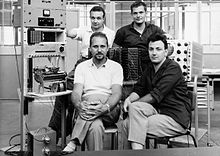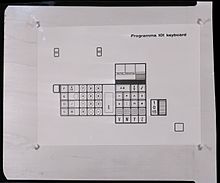Olivetti Programma 101
The Programma 101 (or P101 for short) from Olivetti was the world's first freely programmable desktop calculator and thus a forerunner of the programmable pocket calculator and the personal computer . The design was by Mario Bellini .
history

The Programma 101 was developed by Pier Giorgio Perotto .
The “Programma 101” (also called “La Perottina”) was first presented in 1965 at the BEMA exhibition (Exhibition of Machines for Office Automation) in New York . Series production began in 1965.
The NASA bought ten models and used them to the radio traffic of Apollo 11 to control.
A total of 44,000 calculating machines were produced for the P101.
hardware
The capacity of the built-in runtime memory was around 240 bytes. This computer did not yet have a microprocessor , its CPU was made up of transistors and worked internally with 8 bits in eight 22-digit work registers. These could be split into two 11-digit registers. The data could be uploaded serially to the magnetic wire memory with a magnetic head.
programming
It is only possible to work with alphanumeric data or numbers.
The P101 can handle the four basic arithmetic functions (addition, subtraction, multiplication and division) plus square root, absolute value and storage of the decimal places. It is equipped with memory registers with functions such as clearing, transferring and exchanging as well as printing and pausing for input.
Programming is similar to assembly language , but it's simpler because there are fewer options. It controls the exchange between storage registers and arithmetic registers as well as the operations in the registers.
Earlier computers were expensive and could only be used by experts. The P101 was simple and the programs on magnetic cards in a simple machine language allowed use without knowledge of any programming language.
Specifications
- Size: 610mm × 465mm × 275mm
- Weight: 35.5 kg
- Power consumption: 0.35 kW
- Output device: Printer 30 columns on 9 cm wide paper
- Accuracy: 22 digits and up to 15 decimal places
- Operations: addition, subtraction, multiplication, division and square root
- Memory: approx. 240 bytes
- Archive: magnetic card reader
literature
- Learning to do math with machines The Olivetti Programma 101 in arithmetic lessons at business schools . Jakobi, Frankfurt 1968, OCLC 73831864 .
- Pier Giorgio Perotto: Programma 101: l'invenzione del personal computer: una storia appassionante mai raccontata (= La vita delle imprese ). Sperling & Kupfer , Milan 1995, ISBN 88-200-2111-0 .
Web links
- Olivetti Programma 101 on technikum29.de
- The incredible story of the first PC, from 1965
- A technical description of the Olivetti Programma 101 with a picture gallery (in English) , by Alfredo Logioia.
Individual evidence
- ↑ Desk-Top Size Computer Is Being Sold by Olivetti For First Time in US . In: The Wall Street Journal , October 15, 1965. (Access only possible via login).
- ^ Klaus Dette: Microcomputer pools in teaching . Springer, Berlin / Heidelberg 1989, Olivetti Personal Computer for Teaching and Research, p. 416-418 , doi : 10.1007 / 978-3-642-83857-6_56 .
- ↑ AnnMarie Brennan: Olivetti. A work of art in the age of immaterial labor. In: Journal of Design History. Volume 28, No. 3. 2015, pp. 235-253.
- ↑ kuno.de: Olivetti Programma P101 desktop computer.
- ^ Corrado Bonfanti: 'Pier Giorgio Perotto, una vita da ricordare. In: Mondo Digitale . No. 2 , June 2002, p. 72-77 ( archivio-mondodigitale.aicanet.net [PDF]).
- ↑ Curiosità sulla “Perottina” - Museo Tecnologicamente. In: museotecnologicamente.it. Retrieved November 14, 2016 .
- ^ David W. Whittle: NASA Johnson Space Center Oral History Project in Houston, Texas. (PDF) February 16, 2006, accessed on November 14, 2016 (English, interview with Sandra Johnson).
- ↑ 2008/107/1 Computer, Programma 101, and documents (3), plastic / metal / paper / electronic components, hardware architect Pier Giorgio Perotto, designed by Mario Bellini, made by Olivetti, Italy, 1965–1971. powerhousemuseum.com, accessed November 14, 2016 .
- ↑ Olivetti Programma 101. on technikum29.de, accessed on November 14, 2016.
- ↑ Andreas Stiller: From aftertaste and foretaste. In: c't . heise.de, January 10, 2005, accessed on November 14, 2016 .
- ^ C. Gordon Bell, Allen Newell: Computer Structures: Readings & Examples . Mc Graw-Hill, 1971, LCCN 75-109245 , Chapter 19: The Olivetti Programma 101 desk calculator ( azurewebsites.net ).
- ↑ The incredible story of the first PC, from 1965 ( Memento from August 30, 2012 in the Internet Archive )
- ↑ Programma 101- Memory of Future. (Video) Retrieved July 13, 2020 (Youtube).

